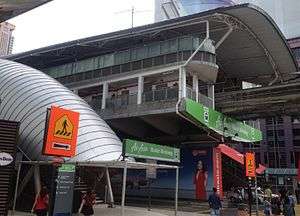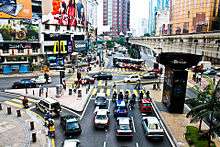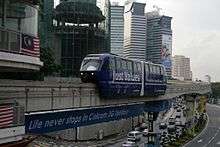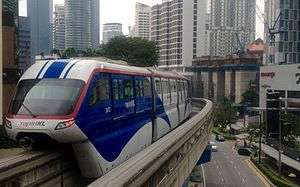KL Monorail
| KL Monorail Line | |||
|---|---|---|---|
|
| |||
|
4-car Scomi SUTRA at MR7 Raja Chulan | |||
| Overview | |||
| Native name | Laluan Monorel KL | ||
| Type | Straddle-beam Monorail | ||
| System | People-mover Rapid Transit (PRT) - SelTrac CBTC | ||
| Status | Operational | ||
| Locale | Kuala Lumpur | ||
| Termini |
NU Sentral Titiwangsa | ||
| Stations | 11 | ||
| Services | KL Sentral-Titiwangsa | ||
| Daily ridership | 68,679 (2015) | ||
| Ridership |
25.067 million (2015)[1] ( | ||
| Line number | 8 (yellow-green) | ||
| Website | http://www.myrapid.com.my/ | ||
| Operation | |||
| Opened | 31 August 2003 | ||
| Owner | Prasarana Malaysia | ||
| Operator(s) | Rapid Rail | ||
| Character | Elevated | ||
| Depot(s) | Brickfields | ||
| Rolling stock |
Scomi SUTRA four-car trains Scomi/MTrans two-car trains Rolling stocks formation | ||
| Technical | |||
| Line length | 8.6 km (5.3 mi) | ||
| Operating speed | 60 km/h (37 mph) | ||
| |||
| KL Monorail Line | ||||||||||||||||||||||||||||||||||||||||||||||||||||||||||||||||||||||||||||||||||||||||||||||||||||||||||||||||||||||||||||||||
|---|---|---|---|---|---|---|---|---|---|---|---|---|---|---|---|---|---|---|---|---|---|---|---|---|---|---|---|---|---|---|---|---|---|---|---|---|---|---|---|---|---|---|---|---|---|---|---|---|---|---|---|---|---|---|---|---|---|---|---|---|---|---|---|---|---|---|---|---|---|---|---|---|---|---|---|---|---|---|---|---|---|---|---|---|---|---|---|---|---|---|---|---|---|---|---|---|---|---|---|---|---|---|---|---|---|---|---|---|---|---|---|---|---|---|---|---|---|---|---|---|---|---|---|---|---|---|---|---|
Legend | ||||||||||||||||||||||||||||||||||||||||||||||||||||||||||||||||||||||||||||||||||||||||||||||||||||||||||||||||||||||||||||||||
| ||||||||||||||||||||||||||||||||||||||||||||||||||||||||||||||||||||||||||||||||||||||||||||||||||||||||||||||||||||||||||||||||
| ||||||||||||||||||||||||||||||||||||||||||||||||||||||||||||||||||||||||||||||||||||||||||||||||||||||||||||||||||||||||||||||||
The KL Monorail Line is an urban monorail system in Kuala Lumpur, Malaysia. It opened on 31 August 2003, with 11 stations running 8.6 km (5 mi) on two parallel elevated tracks. It connects the Kuala Lumpur Sentral transport hub with the "Golden Triangle". It was completed at a cost of MYR 1.18 billion by the KL Infrastructure Group (KL Infra).
The line is one of the components of the Klang Valley Integrated Transit System.
History

The monorail scheme was announced by Kuala Lumpur City Hall in January 1990 after the Malaysian Government gave the go-ahead to the scheme at a cabinet meeting in June 1989. Its cost was then estimated at RM 143 million. The 14-km, 22-station system is designed to carry more than 34,000 passengers a day on a 20-minute loop through Kuala Lumpur's bustling commercial core. The plan is to build it in two phases: in the first, 16 stations will be serviced over 7.7 km; and in the later stage, another 6.5-km loop will be added. The first phase was expected to be completed within two years.[2]
Work was scheduled to begin in June 1990, but was postponed to May 1991, after the city's mayor complained that tenders submitted for preparatory work were too high. There has been no activity on the project since and few details are available on how the project is expected to proceed. The main contractor is a local company, BNK, which had little success in its search for backers to finance its share of the venture. Part of its problem in securing money stems from the project's escalating cost estimates, and part from its lack of a track record in handling such huge projects.[2]
Construction was re-initiated by Hitachi, Ltd., but the 1997 Asian financial crisis led to cessation of work in December 1997. When work was resumed in July 1998, MTrans Holdings took over, locally manufacturing its own rolling stock and completing the project to save cost;[3] the line was completed at a cost of MYR 1.18 billion. As the line was opened in 2003, it was agreed that the parent company and owner of the KL Monorail Line, KL Infrastructure Group, would hold a 40-year concession to operate the monorail. The line and number of stations remains unchanged since 2003.
Since the start of operations, the KL Infrastructure Group suffered losses due largely to depreciation and interest repayment costs.[4] For the financial year to 30 April 2004, KL Infra posted a net loss of MYR 46.24 million on a MYR 15.08 million revenue.[5] KL Infra had also taken up a MYR 300 million Malaysian government loan and a MYR 260 million infrastructure loan from the Bank Pembangunan Malaysia Berhad (BPMB) (The development bank of Malaysia) (Malay: Bank Pembangunan Malaysia, BPM). In addition, KL Infra had proposed to buy MTrans' three subsidiary companies to improve its business, but failed after the Scomi bought up some of the targeted companies.[4]
Government takeover
In April 2007, talks were under way between KL Infra and the government and the Bank Pembangunan Malaysia Berhad to sell the KL Monorail Line to the Prasarana Malaysia, which already owns both the Kelana Jaya Line and the Ampang Line, as well as 10% of KL Infra shares. KL Infra was cited as intending to exit Malaysia's monorail business. The takeover is part of the government's master plan to improve the urban public transport sector.[4][6]
SPN gave its agreement in principle to the takeover on 22 December 2006 and a follow-up meeting was held on 6 February 2007 with the government on the takeover of its operational assets and assumption of loan liabilities. A due diligence audit was conducted from 5 March 2007 to 27 April 2007 by consultants appointed by the government. Following agreement to the takeover, BPM granted KL Monorail an extension until 29 April 2007 for an interest repayment amounting to MYR 4,244,801.91, which was originally due on 29 December 2006.[7]
However, the takeover seemed to have suffered a setback at least from the perspective of KL Infra when on 26 March 2007, it was notified by BPM that it was not going to entertain any further extensions for interest repayment. Subsequently on 27 April 2007, the bank notified that it would not be granting any moratorium on interest repayments. On 29 April 2007, KL Monorail was not able to make the repayment of the interest instalment which had become due.[7]
On 3 May 2007, KL Monorail was issued a default notice by BPM which sought repayment of the entire principal sum of MYR 609,616,423.73 and capitalised interest of MYR 296,428,910.88 totalling MYR 906,045,334.61. The company was granted seven days from that day to repay the entire sum, which it failed to do. On 14 May 2007, Mohd Anwar Bin Yahya and Cho Choo Meng were appointed receivers and managers by Amanah Raya, the Security Trustee for BPM. Nevertheless, the takeover process is still deemed ongoing, KL Infra stating that it will continue to engage the government and BPM to address the proposed takeover of KL Monorail by Prasarana based on earlier discussions and an approval in principle.[8]
One of the effects of the appointment of receivers and managers is the possibility that KL Infra will not be receiving any compensation for KL Monorail should the takeover by SPN go through.[9]
The trading of KL Infra was suspended from 15 May 2007.[10] On the same day, KL Infra's board announced to Bursa Malaysia that it had formed the opinion that it was not solvent and would not be able to pay all its debts in full within a period not exceeding twelve months.[11] On 28 November 2007, Prasarana Malaysia signed a sale-and-purchase agreement with KL Monorail Systems, effectively making Prasarana the operator of KL Monorail, and resulting in Prasarana taking over the MYR 882 million BPM loan.
List of stations
The line consists of a single dual-way line that links areas of inner Kuala Lumpur previously not served by rail transport, namely Brickfields, Bukit Bintang, and Chow Kit, with pre-existing LRT and/or KTM Komuter stations at KL Sentral, Hang Tuah, Bukit Nanas, and Titiwangsa. The two terminis are on a single track.
The stations are designed as elevated structures with ticketing facilities on either the ground level (as seen in the KL Sentral station) or the first-floor level. The platforms are on the top floor, separated from the monorail lines by fencing. They were originally covered by large canvas roofs, which were replaced in 2014 by aluminium zinc roofs.[12] Certain stations are situated above roadways, or are slightly longer than others. Each station used to be designated with a sponsor, with route maps associating each station with a particular product brand.
The depot is between KL Sentral and Tun Sambanthan.
| Station Code | Station Name | Platform type | Interchange/Notes |
| MR1 | KL Sentral Monorail ( KJ15 KL Sentral) | Terminal | 250 meter connecting station require exit the station paid area to Seremban Line, Port Klang Line, Kelana Jaya Line, KLIA Ekspres Line & KLIA Transit Line. Despite the similar rail transit station name, a different fare will be charged to passenger who using cash & TnG, however exceptional for MyRapid card. The upcoming Muzium Negara for Sungai Buloh-Kajang Line will provide rail transit connection more than 850 meter walking distance. |
| MR2 | Tun Sambanthan | Side | |
| MR3 | Maharajalela | Side | |
| MR4 SP9 | Hang Tuah | Side | An interchange station to Sri Petaling Line platforms. |
| MR5 | Imbi | Side | |
| MR6 | AirAsia - Bukit Bintang | Side | An interchange station to the upcoming underground station platform of Sungai Buloh-Kajang Line. |
| MR7 | Raja Chulan | Side | |
| MR8 | Bukit Nanas ( KJ12 Dang Wangi) | Side | 250 meter walking distance exit paid area station to KJ12 Dang Wangi station on the Kelana Jaya Line. |
| MR9 | Medan Tuanku | Side | |
| MR10 | Chow Kit | Side | |
| MR11 SP3 | Titiwangsa | Terminal | An interchange station exit to Sri Petaling Line platforms. |
Expansion
To some extent, the line has been designed to accommodate future expansion. While some stations are significantly longer than the current 2-car sets, providing room for longer train sets, extension works for other stations have been necessary. An expansion project known as The KL Monorail Fleet Expansion project is being carried out by Prasarana to ensure a more efficient and user-friendly monorail services in the future. The installation of the Platform Automatic Gate System (PAGS) is one such work under the project. This gate system is necessary to improve passenger safety as before this, there are no barriers between the passenger platforms and the tracks and this may pose dangers to the users. The project also includes the installation of a new signalling system, construction of a new depot to accommodate larger train sets and other station upgrades and universal access facilities.
An example of station upgrades are at Bukit Bintang station. Touted as one of the busiest stations of the line due to its proximity to Bukit Bintang, the hub of shopping and entertainment in Kuala Lumpur, it used to have only one exit, but the upgrading project now provided the station with added an alternative entrance and exit walkway and a direct entry to the Lot 10 and Sungei Wang Plaza shopping complexes. The monorail station is also equipped with new ticket vending machines and ticketing gates. Other than that, escalators and lifts as well as a new Customer Service Office are also provided. Another example of station upgrades is at the second busiest monorail station, Kuala Lumpur Sentral station, where the Nu Sentral overhead bridge becomes the new entrance to the station. Previously, the monorail users needed to exit KL Sentral and cross the busy main thoroughfare in Brickfields to reach the station. The completion of the overhead bridge now enables customers to travel between KL Sentral and the monorail station safely and conveniently.[13][14][15]
The fleet expansion project main goal is however the introduction of new, state-of-the-art four-car trains. Two four-car trains have been introduced to the public while the rest will be delivered in stages until the fourth quarter of 2015. The new four-car trains can accommodate up to 430 passengers per trip and could significantly reduce the waiting time for passengers besides being more comfortable and spacious than the current two-car trains. After all sets of four-car trains have been delivered and commissioned into the system, the two-car sets, which have been in operational since 2003, would be retired. Besides having a larger capacity, the new trains are also fitted with better safety features including open-door window, on-board close-circuit TV cameras and “run-flat” features, which allow the trains to continue moving despite a puncture.[16][17]
Rolling stock
The line uses permanently coupled two-car trains of a similar design to the Seattle Center Monorail's ALWEG trains.[3] Each monorail train can accommodate 158 passengers during regular operations. The monorail carriages themselves were constructed by Scomi Rail, a Malaysian monorail manufacturer,[3] at the Scomi Rail plant in Rawang, which also featured its own tracks for monorail train tests.[18]
In December 2014, KL Monorail began putting the first two of its four-car trains into service[19] The Scomi SUTRA monorails were designed and manufactured by Malaysian rail company Scomi Rail. Each train can accommodate 430 passengers per trip, compared with 213 passengers for the two-car trains.[19] Two more four-car trains are scheduled to arrive in the first quarter of 2015 with the remaining eight arriving in stages. All the four-car trains are scheduled to be in operation by the end of 2015.[19] Upon the delivery of the new four-car trains, the original two-car trains which have been in use since KL Monorail opened will be decommissioned.[19] The new trains are equipped with four closed-circuit television cameras and space for wheelchairs and strollers.[19]
Accident and incidents
David Cheliah accident
Prior to the opening, on 16 August 2002 an accident occurred during a test run involving a 13.4 kg (30 lb) safety wheel falling off a train and hitting the head of a pedestrian walking under the monorail viaduct at Jalan Sultan Ismail. The victim, David Cheliah, a journalist, suffered injuries that required hospitalisation.
On 7 March 2003, Cheliah filed a MYR 5 million negligence suit against the companies involved in the design, installation and operation of the trains, as well as the Director-General of Railways.[20][21] On 8 April 2009, the High Court ruled that the Monorail company was liable for the incident, but not the Director-General of Railways. Although the monorail company reported that any such accident was "unlikely" as six bolts would have to be removed for it to occur and furthermore, a check of all 23 other safety wheels on the train involved did not turn up any other issues, the high court judgement ruled that the monorail company "failed to provide a reasonable explanation as to how the safety wheel had come off the train and instead relied on the possibility that there had been tampering by unknown persons".[22][23]
As a result of this accident, the launch of the monorail was postponed.
Burst tyre incident
On 22 January 2005, a pneumatic load tyre suddenly burst and caused two women passengers to be injured. The train, carrying about 30 passengers, was about to move from the Chow Kit Road station to the Titiwangsa station when the incident occurred at about 8.50pm. The burst tyre caused a rubber sidewall panel to flip open which then hit the side of a passenger seat and injured a woman's legs and another woman's hands. Train services were suspended for about 30 minutes following the incident.[24]
Breakdown
On 11 August 2012, a train stalled near Tun Sambanthan in Brickfields. The breakdown caused 183 passengers to be trapped for about two hours. The air conditioning system in the carriage was stopped when the power supply was cut. As a result, some passengers had to break the windows to allow air in while awaiting rescue. Fire and Rescue Department personnel later used a skylift to rescue passengers trapped in the carriage.[25] Investigation revealed that the issue was due to a power supply disruption at the circuit breaker, causing the auxiliary power system to fail.[26]
Six days later, another break-down occurred. A train stalled between Imbi and Bukit Bintang for about 30 minutes, trapping around 200 passengers. This time however, there was power in the train and the air conditioning system was functional. The train services resumed after half an hour.[26]
Titiwangsa station on fire
On 30 March 2015, A monorail service was temporarily delayed when a tyre of a two-car train coach caught fire at the Titiwangsa Station. The scene was recovered hours later [27]
Gallery
 SCOMI Sutra 4-car trainsets for KL Monorail
SCOMI Sutra 4-car trainsets for KL Monorail KL Monorail 4-car trainset no. 1 at Rawang facilities
KL Monorail 4-car trainset no. 1 at Rawang facilities- KL Monorail 2-car trainset approaching Hang Tuah station
- KL Monorail 2-car trainset approaching Hang Tuah station
- Train at Tun Sambanthan station.
- A view from above the Bukit Nanas KL Monorail station and adjoining tracks.
 Track switch near KL Sentral station.
Track switch near KL Sentral station. View from Bukit Bintang station.
View from Bukit Bintang station. Monorail train approaching Bukit Bintang station.
Monorail train approaching Bukit Bintang station. Train in Al-Rajhi Bank livery approaching Medan Tuanku station.
Train in Al-Rajhi Bank livery approaching Medan Tuanku station..jpg) The interior of a KL Monorail 2-car trainset.
The interior of a KL Monorail 2-car trainset._(exterior)%2C_Kuala_Lumpur.jpg) The exterior of the Titiwangsa terminal station.
The exterior of the Titiwangsa terminal station._(exterior)%2C_Kuala_Lumpur.jpg) The exterior of the Kuala Lumpur Sentral terminal station before modification project.
The exterior of the Kuala Lumpur Sentral terminal station before modification project. Monorail Moments Arriving At Bukit Bintang.
Monorail Moments Arriving At Bukit Bintang.
References
- ↑ "JADUAL 2.9 : BILANGAN PENUMPANG BAGI PERKHIDMATAN SISTEM ALIRAN RINGAN, SUKU KEEMPAT, 2015" [Table 2.9 : Number of Passengers for Light Rail Transit (LRT) Services, Fourth Quarter, 2015] (PDF) (in Malay and English). Ministry of Transport, Malaysia. Retrieved 31 March 2016.
- 1 2 Doug, Tsuruoka (26 September 1991). "Off the Rails: Kuala Lumpur's Monorail Project Becomes Bogged Down". Far Eastern Economic Review.
- 1 2 3 "Monorails of Asia - Kuala Lumpur, Malaysia". The Monorail Society. Retrieved 2 September 2014.
- 1 2 3 "KLIG in talks to exit monorail business". New Straits Times (Business Times). Kuala Lumpur. 25 April 2007. Retrieved 2007-04-25.
- ↑ Abu Bakar, Dalila (24 September 2004). "MTrans upbeat on mass transit project in W. Asia". New Straits Times (Business Times). Kuala Lumpur. Archived from the original on 13 February 2007. Retrieved 2 September 2014.
- ↑ "Syarikat Prasarana Negara in talks to take over KL monorail". The Edge. Kuala Lumpur. 24 April 2007. Archived from the original on 27 April 2007. Retrieved 2007-04-25.
- 1 2 "Bursa Malaysia General Announcement: Default in Payment Pursuant to Practice Note No. 1/2001 of the Listing Requirements of Bursa Malaysia Securities Berhad". 30 April 2007. Archived from the original on 7 February 2012.
- ↑ "Bursa Malaysia General Announcement: Appointment of Receivers and Managers for KL Monorail System Sdn Bhd (KLMS)". 14 May 2007.
- ↑ Lim Ai Leen (21 May 2007). "Corporate: Puzzle over bank's move on KL Monorail". The Edge. Kuala Lumpur. Archived from the original on 2007-09-28. Retrieved 2007-05-23.
- ↑ "Bursa Malaysia General Announcement: KL Infra - Suspension of trading". 15 May 2007.
- ↑ "Bursa Malaysia Announcement: Default in Payment Pursuant to Practice Note No. 1/2001 of the Listing Requirements of Bursa Malaysia Securities Berhad". 15 May 2007.
- ↑ Prasarana: First Pair Of New 4-Car Monorail In Operations In Third Quater 2014 [sic]; Malaysia Industry-Government group for High Technology; April 9, 2014. URL last accessed 2014-12-03.
- ↑ "First Look: Nu Sentral Mall at KL Sentral, Brickfields Review - VenusBuzz.com/Malaysian Women's Lifestyle". Venusbuzz.com. 2014-04-01. Retrieved 2015-03-15.
- ↑ "New Wing Of Bukit Bintang Monorail Station Opens Today". MyRapid. Retrieved 2015-03-15.
- ↑ "Kosmo! Online - Terkini". Kosmo.com.my. 2014-09-20. Retrieved 2015-03-15.
- ↑ vijenthi nair (2014-08-16). "New four-car monorail trains operating from next month - Community | The Star Online". Thestar.com.my. Retrieved 2015-03-15.
- ↑ "Passengers Give Thumbs Up For New Four-Car Train". MyRapid. Retrieved 2015-03-15.
- ↑ "Kuala Lumpur Monorail - a Photo Essay (page 1/13)". The Monorail Society. Archived from the original on 8 March 2007. Retrieved 2007-04-25.
- 1 2 3 4 5 "Four-car trains make debut". New Straits Times. 22 December 2014. Retrieved 22 December 2014.
- ↑ "Long-drawn monorail case to be decided on 8 April". Retrieved 2009-07-30.
- ↑ "David Chelliah vs Monorail Malaysia Technology Sdn Bhd". Archived from the original on 5 May 2006. Retrieved 2009-07-30.
- ↑ "Bernama journalist to be awarded damages". The Star. Kuala Lumpur. 9 March 2009. Retrieved 2 September 2014.
- ↑ Raj, Reena. "Chelliah finally wins it". Malaysian Bar Council. Retrieved 2 September 2014.
- ↑ "Burst tyre cause of monorail explosion" (PDF). Archived from the original (PDF) on 7 December 2008. Retrieved 2009-07-30.
- ↑ http://www.thesundaily.my/news/461509
- 1 2 Lilana Mokhtar, Ily. "KL monorail stalls again". New Straits Times Press. Malaysia. Retrieved 2 September 2014.
- ↑ http://www.themalaysianinsider.com/malaysia/article/fire-reported-at-titiwangsa-monorail-station#sthash.187Wpa2C.dpuf. Missing or empty
|title=(help)
External links
| Wikimedia Commons has media related to Kuala Lumpur Monorail. |
- Construction - Monorail extension to Old Klang Road/Sunway Overweight
- Kuala Lumpur Monorail - a Photo Essay at the Monorail Society
- Land Public Transport Commission
- Prasarana Malaysia
- MyRapid
- Klang Valley Mass Rapid Transit Project
- TransitMy
- App Store
Route Maps
- Route search - Interactive transport guide of Kuala Lumpur public transport system
- Train Journey Planner & Fare Calculator from thepricechat.com
- Route Map from stesensentral.com
